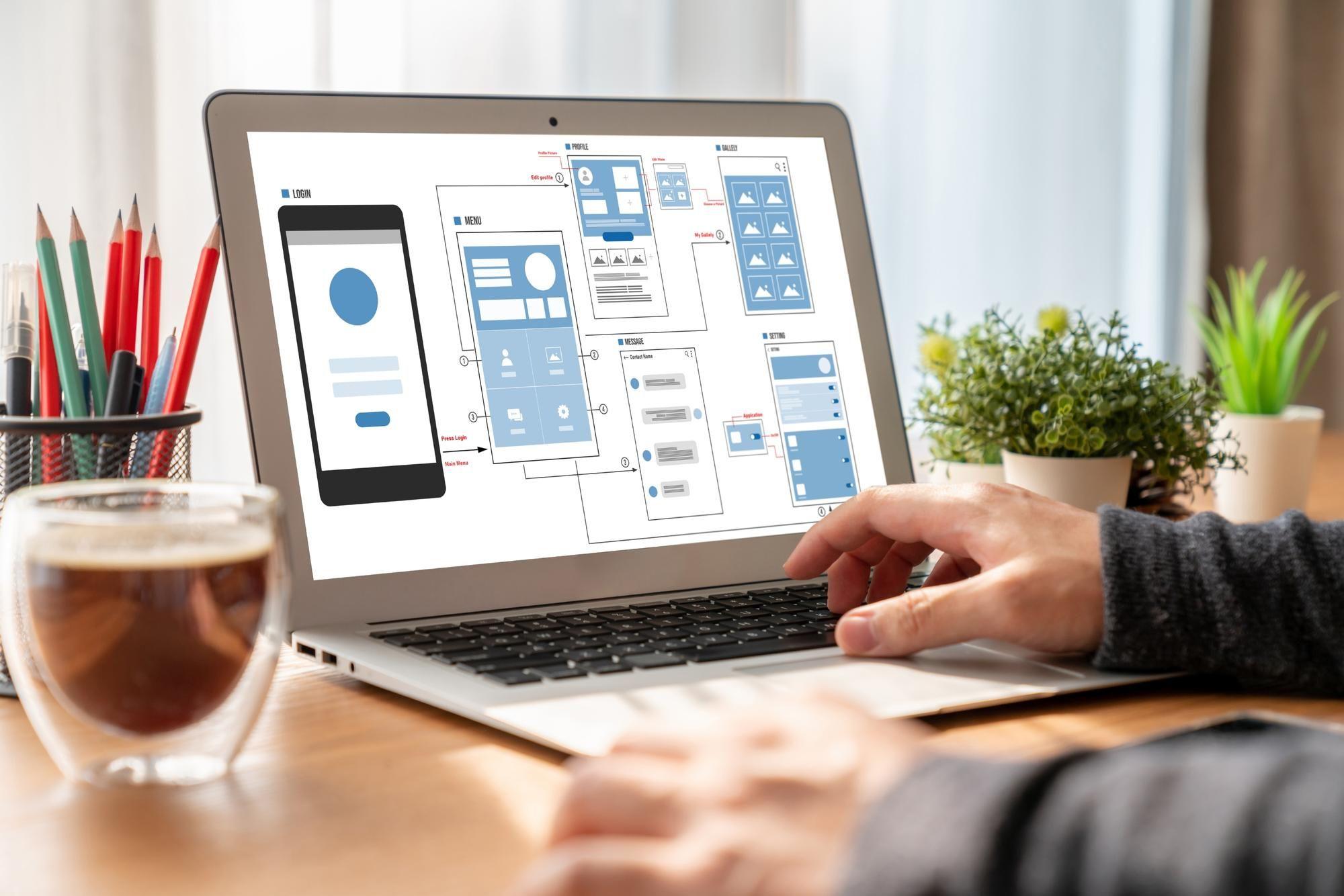Technical Feasibility in Software: Types, Benefits, and Conducting Methods
Introduction
In 2019, Google announced a much-anticipated gaming platform, Stadia, designed to allow users to play high-quality video games on any device with an internet connection. However, the platform faced criticism for a limited game library and technical issues such as lag and stuttering during gameplay. Google later shut down its internal game development studios as the cloud-based streaming service ultimately proved unsuccessful.
There are several potential causes for a product launch failure. The most common is the need for an excessive amount of resources, which not only prohibits those resources from being used for other tasks but may also result in high costs and low returns.
Before launching a product, you must ensure its success by conducting a technical feasibility analysis in software development.
A technical feasibility study in software engineering provides vital information about the project and helps to refine its specifications, preventing costly errors during implementation.
Below is a list of some other goals that can be attained by doing a technical feasibility study in software engineering:
- Assessing how well the program fits the needs of the business.
- To ascertain whether the program can be built with the available resources (time, money, and infrastructure).
What is Feasibility in Software Engineering?
Assessing the realistic potential of a software project is what we call "feasibility" in the software development industry. An essential aspect of any software engineering planning process is a thorough feasibility study demonstrating the potential future advantages of software to the business and the organization's capability of developing such software efficiently with its current resources. Several distinct kinds of technical feasibility analyses are performed during software development.
What is Technical Feasibility?
No matter how small, every company opens up to risk (like product scalability, performance deployment, etc.) regarding the software it builds or purchases. But, these risks can be avoided initially by verifying the viability of a software project and ensuring its long-term success in today's competitive environment.
Technical Feasibility (TF) analysis in software development can be carried out to verify this hypothesis and learn more about the potential outcomes of the proposed project. This applies across all sectors, providing a brighter future for software development.
Technical feasibility involves evaluating the technical expertise of the development team, the feasibility of selected technologies, and their ability to meet market needs. The analysis encompasses various technical, organizational, financial, and other factors to determine the project's technical and economic feasibility.
The technical feasibility study in software engineering is conducted in various ways depending on the company. Some people may do it in a precise and organized method, while others may do it as needed. However, you must have the following resources -
- Hardware
- Software
- Technology
- Skills and knowledge
- Time and budget for development
- Specialists
- Software development tools
Finding the right technology suitable for your project can be challenging, which could negatively affect your schedule, finances, and other goals. It's crucial to prioritize selecting the most appropriate technology and developers for the success of your project.
Feasibility Analysis: Why You Need It
Feasibility analysis aids in determining the potential success or failure of a plan, venture, or product. The technical feasibility in software engineering looks at the concept's profitability and whether or not it can be implemented with the available resources. Furthermore, it will show the returns earned for the risk of investing in the concept.
Types of Feasibility
Feasibility can be categorized into five different types called the TELOS framework, focusing on five key areas of feasibility.
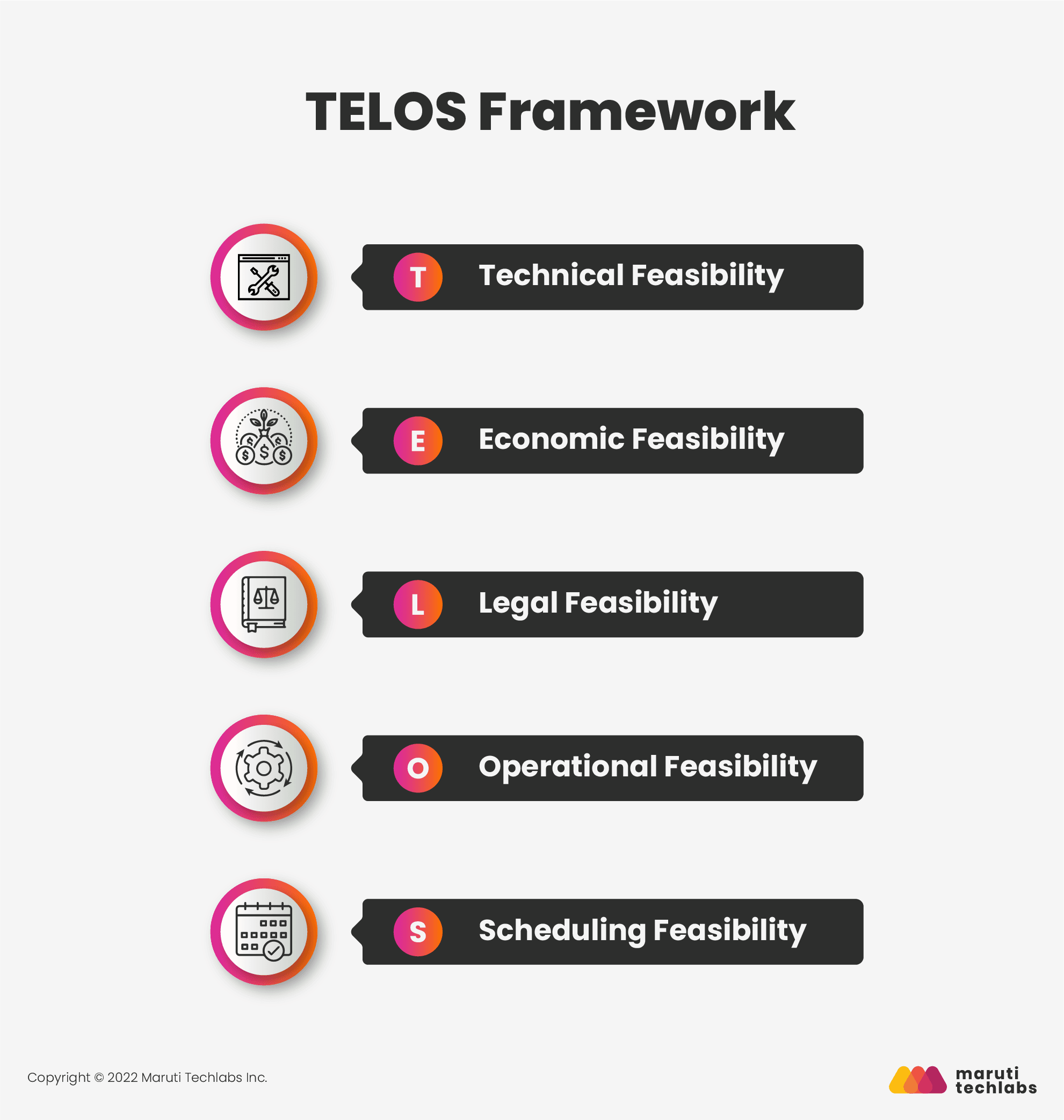
1. Technical Feasibility
The technical feasibility analysis in software development determines if the program can be developed given the resources and talent pool.
2. Economic Feasibility
The economic viability of a project considers both the costs and potential returns. Therefore, making a ROM (Rough Order of Magnitude) estimate is normal practice to ascertain financial viability.
3. Legal Feasibility
Considering the product's legal viability ensures it won't get you in trouble. For instance, HIPAA compliance is required for any medical software that handles PHI (Protected Health Information). In addition, you must investigate the potential legal threats to your project and how best to mitigate them.
4. Operational Feasibility
Implementing a project within the current business environment might impact daily operations. Operational feasibility involves analyzing the practicality of implementing the project within the current business environment and determining how it will impact daily operations.
5. Scheduling Feasibility
Deadlines and maintaining momentum toward those targets. For a comprehensive feasibility analysis, one must understand the financials, technologies, and regulations. It's easy to see why companies use third-party researchers to conduct their experiments.
Exploring Project Viability Beyond Technical and Economic Aspects
Organizational Viability
The organizational structure, including its legal framework, management team's expertise, etc., is the primary subject of organizational feasibility analysis. This process ensures the necessary resources are available to launch the company plan.
Operational Viability
How well the solution fits the company, what the company needs from the solution, and what the client anticipates from the system are all factors in this category.
Timeline Feasibility
It outlines project milestones, the effects of delays, and the point at which the expected time to complete the activities surveyed crosses into reality.
Theoretical Part: A Technical Feasibility Study
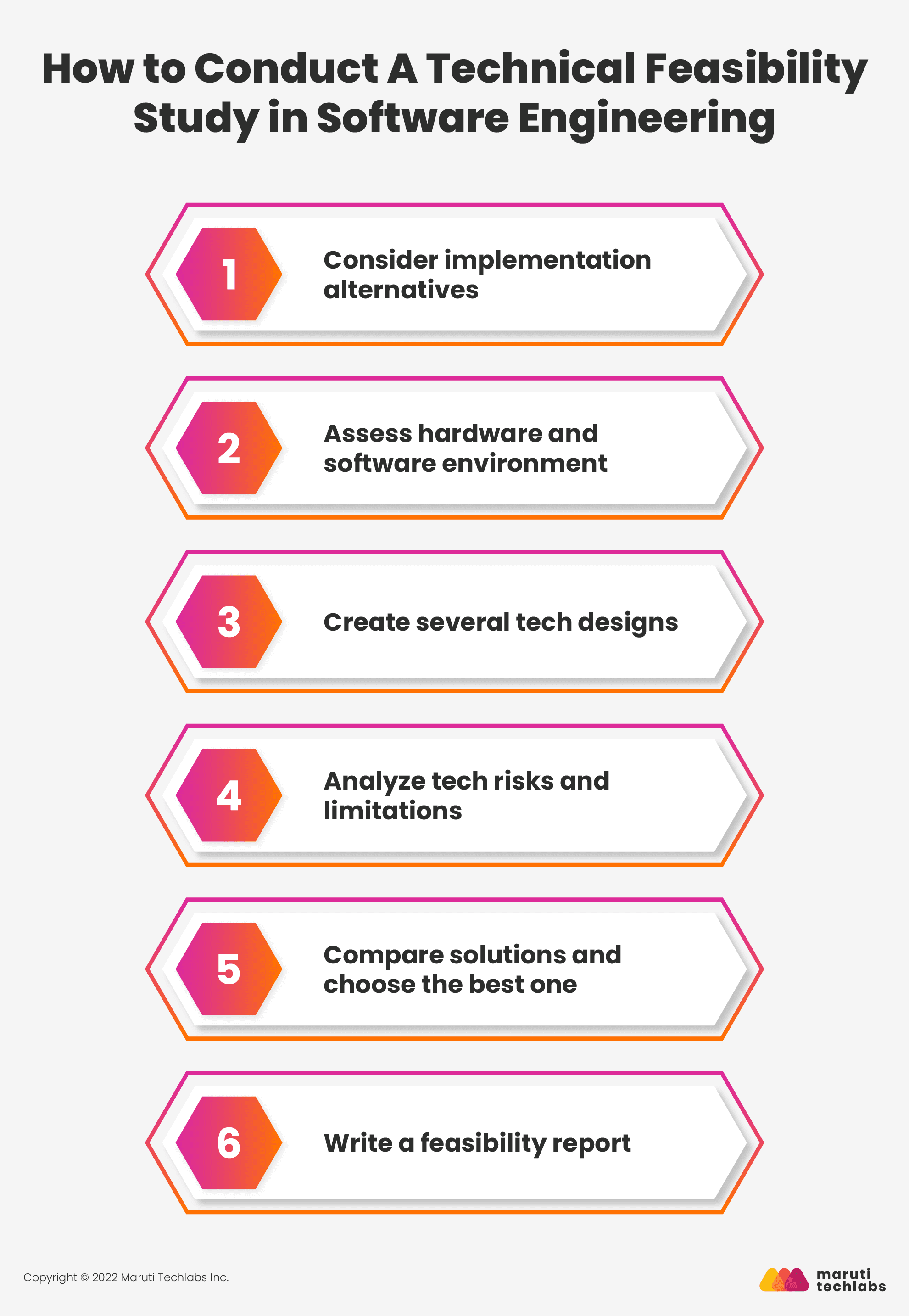
An in-depth investigation into the technological aspects of the planned project is called a technical feasibility study in software engineering. A technical feasibility study discusses topics such as
- Hardware and software components
- Possibilities and limits posed by technology
- Interoperability with other information technology
- The technical skill set of your engineering staff
A specific order of events must be followed in a technical feasibility study to achieve the desired results, and we'll be breaking that down for you.
Consider Implementation Alternatives
The first step is to think about potential ways to implement the plan. In this area, we frequently have multiple options.
Do Nothing
Technical feasibility in software engineering may conclude that the current setup is the best. However, sometimes the benefits of innovations are marginal, but the risks and costs are disproportionate.
Go with ready-made software and customize it to fit your requirements. Purchasing a ready-made application or combining with a white-label solution and customizing it to suit your needs is often the best option.
This is especially true for widely-used applications like customer relationship management software or large, complicated infrastructures requiring development for years. Big, complex platforms include hotel property management software, airline passenger service software, and hospital electronic health record software.
The following criteria should be evaluated thoroughly before purchasing a finished good:
- Performance
- Learning simplicity
- Low difficulty in setting up and using
- The vendor's level of assistance
- Scalability
- Options for licensing
Though you don't have to create everything from scratch, there is still much work to be done, such as developing and testing APIs, making customizations to code (if using open-source software), and ensuring everything works together.
Create a Custom System
With custom development, you can satisfy your business needs. Assuming the project is practical (i.e., it can be finished in the allotted time and budget), the next stage is to look at the technologies and architecture employed.
Assess Hardware and Software Environment
Whether you go with a premade solution or build one from scratch, you'll need to take stock of your company's hardware and software to answer the question, "Can we run the project in our current environment?"
A system's everyday dependability is no guarantee of its continued dependability in the future. For example, performance can suffer when the number of users on the system increases.
This is often the case when the system users jump from 10,000 to 100,000 or from 1,000,000 to 10,000,000. As a result, it could deal with far more information than before.
The capacity of a system to handle an increase in its workload is referred to as its "scalability." However, it is essential to remember that scalability is not a binary attribute that can be applied to a system; it makes no sense to claim that X scales but Y does not.
Instead, while talking about scalability, it's essential to ask yourself, "If the system grows in a certain way, what are our options for dealing with the growth?" Furthermore, “How can we increase our computing resources to accommodate the escalating demand?”
When assessing the state of the IT network, there are a few other factors to consider. Security flaws are a significant concern, especially if you intend to maintain and process sensitive data. Think about how well the systems will work with hardware and software from other manufacturers.
Create Several Tech Designs
A technical feasibility study in software engineering will give multiple design options representing the target system. Each one should provide a broad view of the problem and its solution, including -
- The general framework for an app, its primary components, and how they work together.
- The infrastructure design collects, transforms, and stores data.
- Mechanisms for ensuring privacy, safety, and connectivity to third-party data stores, services, and other systems.
Analyze Tech Risks and Limitations
Assess the importance of technical feasibility in software engineering, the technical hazards associated with each choice, and the practical considerations.
The list is not limited to the following items:
- Dependencies on a third party
- Utilization of underdeveloped technology
- Employing novel methods as a group
- Managing incompatible, pre-existing infrastructure
The next step is investigating each suggested architecture's potential risks and technical restrictions.
That is, focus on,
- Limitations on performance
- Issues with the implementation
- Concerns about scalability
- Concerns about expendability
- Difficulties in providing maintenance and assistance
When all relevant data is available, deciding is as simple as picking the best one.
Compare Solutions and Choose the Best One
As the next step in the technical feasibility study, a decision matrix can help you evaluate potential options and determine the best action.
Here’s an example!
| Solution 1 | Solution 2 | Solution 3 | Solution 4 | |
| Alignment With Business Goals | 5 | 4 | 3 | 5 |
| Performance | 5 | 3 | 4 | 5 |
| Scalability | 4 | 3 | 2 | 3 |
| Cost | 2 | 4 | 5 | 3 |
| Potential Risks | 4 | 3 | 2 | 4 |
| Duration | 3 | 5 | 4 | 3 |
| Legal Fit | 5 | 4 | 4 | 3 |
| Security | 5 | 4 | 1 | 4 |
| Ease of implementation | 2 | 4 | 4 | 3 |
| Ease of maintenance | 3 | 5 | 5 | 3 |
| Total | 38 | 39 | 34 | 36 |
As seen in the table above, Solution 1 may offer superior performance. Still, it will set you back twice as much as Solution 2. In addition, it creates difficulties in upkeep that necessitate recruiting new specialists or engaging third-party assistance.
This reduces the practicality of Solution 1, which means it is less preferable. However, please remember that the decision matrix is just provided as a reference and is intended to be followed differently.
Write a Feasibility Report
A feasibility report is the natural product of technical feasibility analysis in software development. The format varies from business to business, but most policies include the following components.
- Overview - Provide a high-level summary of the project's goals, scope, and issues you want to address.
- Explaining the Current Scenario - Describe the issues plaguing the current IT infrastructure. Define the current system requirements, including the hardware, operating system, and software features.
- Consideration of Alternatives - Provide details on accomplishing the project's objective using original and pre-existing resources. Establish primary standards to evaluate them, such as how well they serve the stated purpose, costs, etc. Emphasize the positive outcomes. Call attention to your suggestion and explain why you have settled on that one.
- Analyzing Dangers - Identify any legal or other potential hazards or limitations associated with the chosen option(s) and propose solutions.
- Recommendations - Provide an overview of your research's most important conclusions and suggest the next steps.
Practical Part: Feasibility Testing and Demonstration
Risks may be further reduced once the best designs have been selected and a feasibility report has been created by conducting a product hypothesis test. This can be done through Proof of Concept (POC), a prototype, and a minimum viable product or MVP.
Though these phrases are often used interchangeably, they refer to distinct processes at various points in a product's development and have distinct goals and resource requirements.
A technical feasibility study is only indirectly related to the proof of concept. However, we will also consider the other two choices because they are closely related and work toward the same overarching goal: learning before spending.
- Create a Prototype to Verify the Viability of the Technology
Business analysts and user experience/interface designers are integral to this process.
A proof of concept is an early prototype of an idea or product intended to convince internal stakeholders and potential investors that the idea has merit. It's the quickest and least expensive technique to verify that your chosen solution works as intended in a given setting.
If you don't like the results, try something else or give up on the concept altogether. To ensure that your AI/Data Engineering project is successful, we put extra effort into creating a proof-of-concept or prototype.
The POC might be of any appearance; this is not a requirement. It might be a manual, a presentation, a diagram, a wireframe (a rudimentary mockup of the final user interface), or any mix of these. Creating a proof of concept can often be done without writing any code.
Though POC experiments are not required, they are highly suggested for creating novel items that still need to be created on the market.
- Create a Trial Version of the Interface
Prototyping is the next step after proof of concept that may be taken to test your product further. A prototype is an early version of a system that lacks the full features and engineering of the final product.
The proof-of-concept is transformed into an interactive prototype that displays the user's journey graphically. Design faults may be rapidly found and fixed using real-world user feedback. This way, potential backers and buyers may sense the finished product.
- Create a Minimum Viable Product (MVP) to Determine Market Interest
Managers and programs are experts contributing to the project. Based on the proof of concept, prototype, and software requirements specifications, a Minimum Viable Product (MVP) is created.
It has the key features that users need, and it's introduced to the market so that more people may use it, provide feedback, and be analyzed to make any required adjustments. Assuming this is an effort to create a new product, we will concentrate on the minimum viable product.
Launch
How in-depth do feasibility studies need to guarantee success and prevent unpleasant shocks during implementation? The more original your idea is, the more thorough your analysis should be.
When working on NVP, a major redesign, or significant feature additions, you can split up your monolithic system into smaller components called “microservices.”
Let us rephrase it. Is there ever a time when a feasibility study would be pointless? Certainly, but you can count them on the fingers of one hand.
- You believe strongly that your plan can be executed successfully.
- You've conducted a project or research within the previous three years with similar goals.
- The scope and complexity of your project need to be higher to affect the company's long-term objectives significantly.
In every other case, you need to do a feasibility study to determine whether or not the software is worth the investment and how much it will cost to make any changes to the original design.
Conducting a Feasibility Study based on Project Status [New project v/s Inherited Project]: A Step-By-Step Guide
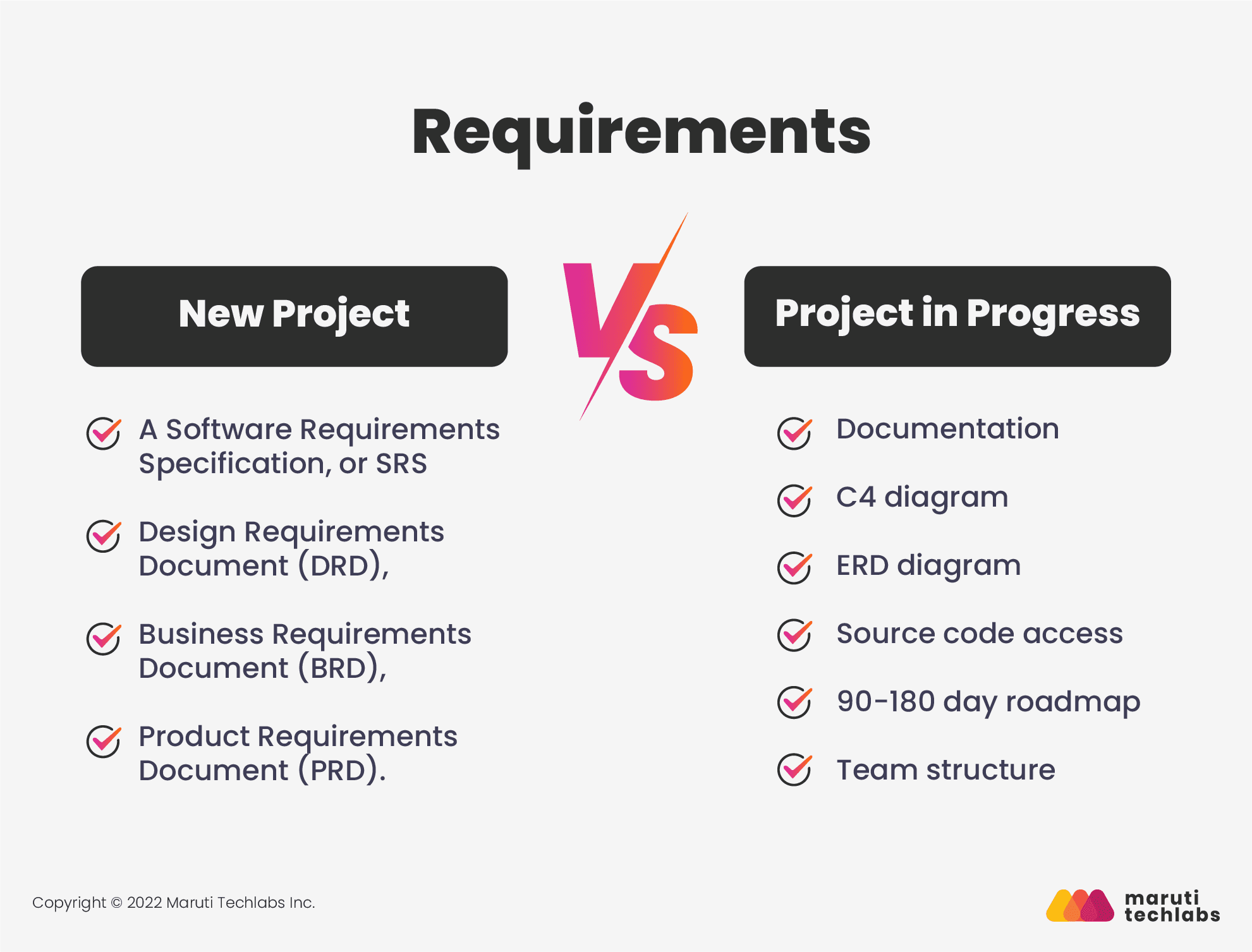
Step 1: Brainstorming Different Methods for Project Execution
Before getting software for your company, it's important to consider different implementation methods based on your feasibility study's findings. Keep these options in mind from the beginning of the process.
- Don't use any software for now.
This is an alternative worth considering. After doing the math, you can decide that the current system is sufficient and that switching to anything new is not worth the effort.
- Select a premade product that will be modified to fit specific needs.
A pre-built solution or product is the best alternative for customer relationship management systems. It is also best for complicated systems with infrastructure too expensive for a single organization to design and maintain.
In addition to a fully-customizable product, many SaaS providers provide round-the-clock technical support and regular updates. Here are some things to think about before settling on a third-party service:
- Performance
- Reliability
- Alternatives for personalization
- Price regularly (either monthly or annually)
- Compatibility with your current software
- Obtaining the appropriate permits and following the law
- Access to support
- Scalability
- Ease of use
You must also ensure that the new software is compatible with your existing system, test its APIs, and modify its code even if you purchase ready-made software. You may also need to train your employees.
Limited customization, reliance on a third-party corporation, and the necessity to adapt internal business processes to your software are all disadvantages of utilizing off-the-shelf software.
Third-party solutions often fall short for organizations because they involve too much modification, offer too many features, or may lack certain features. Therefore, creating a custom solution can be the best option.
- Build a custom solution.
Now you have decided to develop a custom system. You have complete authority over and input into developing software explicitly tailored to your company. You may make whatever adjustments you choose to your program, and the choices of any other organization do not restrict you.
Your approach to creating your software also impacts a project's viability. For example, weigh the pros and cons of working with in-house programmers vs outsourcing. Instead of contracting out their development, some organizations recruit freelancers or add employees from outside the company.
Certain options may not work because of the time and money required for the recruiting procedure, while some options may work.
You should undertake a feasibility analysis that factors in the expenses of each development option you're considering.
Step 2: Documentation, Analysis, and Roadmap for Projects in Progress
a) For a brand-new project, the following paperwork is required: (provided by the client)
- A Software Requirements Specification, or SRS
- Design Requirements Document (DRD), Business Requirements Document (BRD), and Product Requirements Document (PRD).
We use this information to carry out a workshop that spans a maximum of one or two weeks.
The workshop is complementary to the feasibility study. Technical viability, idea validation, and investor presentation assistance are provided throughout the program. During the workshop, we'll lay out a clear plan for what needs to be completed and identify any issues that might arise from doing so for the firm.
b) The following is required for a project that is already in progress
- Documentation
- C4 diagram
- ERD diagram
- Source code access
- 90-180 day roadmap
- Team structure
Step 3: Code and Architecture Audit
Maruti Techlabs conducts an evaluation that includes a Code and Architecture Audit and a feasibility analysis against the business case.
Step 4: SWOT Analysis
The next objective is to conduct a SWOT analysis on all facets of the product (code, architecture, DevOps, security, etc.)
Step 5: Project Reporting
We next provide the client with our report and analysis and a roadmap, including the features we plan to implement in the next three, six, and twelve months, all of which are considered near-term.
Structure of a Feasibility Report
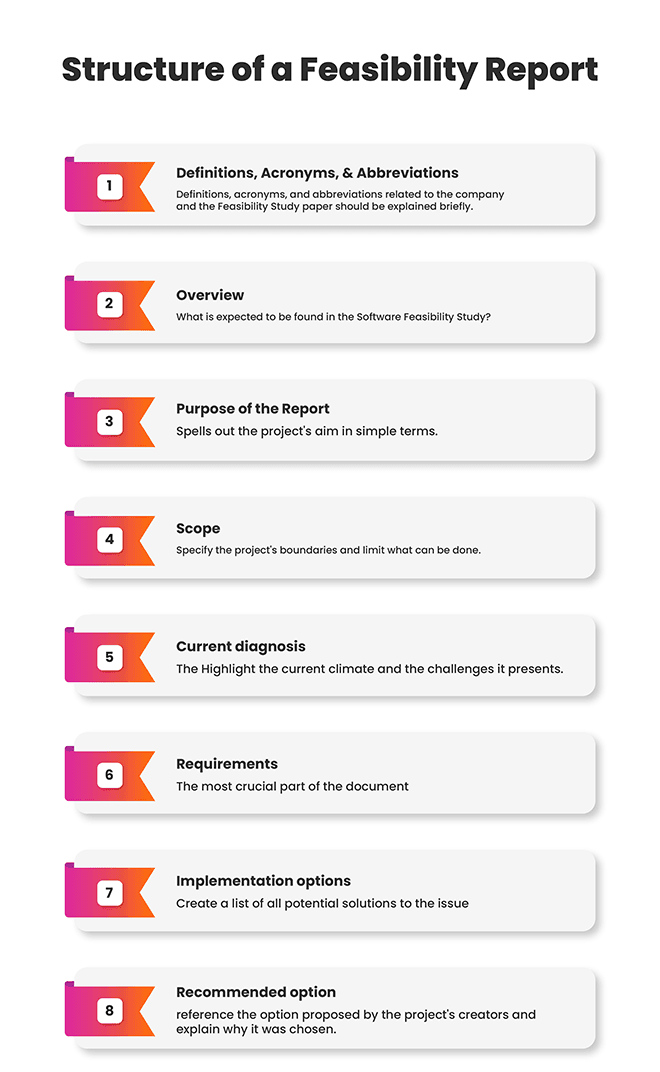
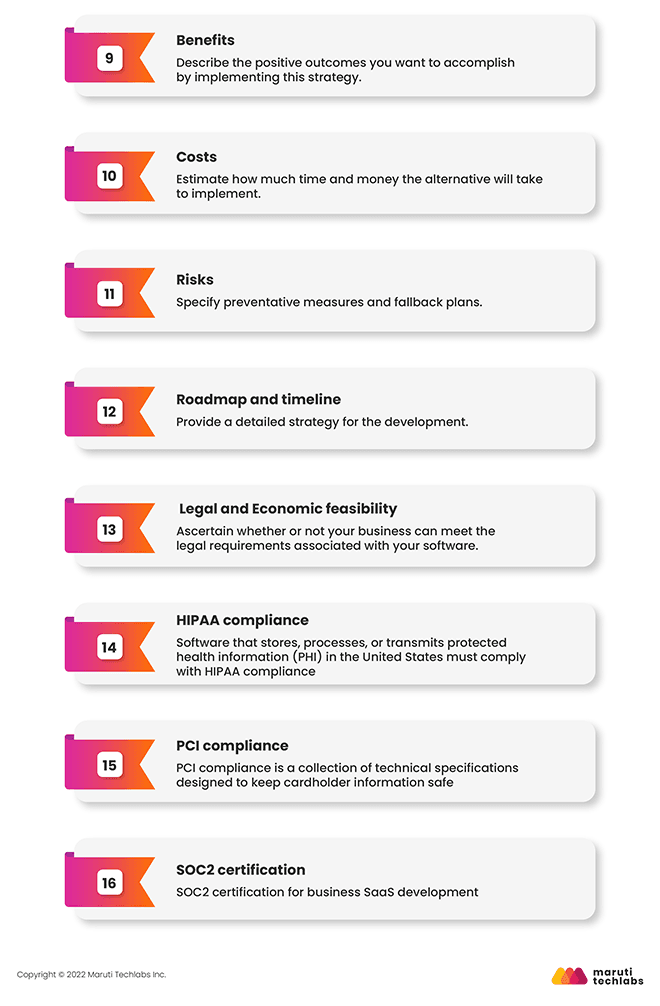
- Definitions, Acronyms, and Abbreviations
Definitions, acronyms, and abbreviations related to the company and the feasibility study paper should be explained alphabetically for clear understanding. If not, explain why it is irrelevant.
- Overview
Describe what else may be expected to be found in the software feasibility study in the overview section. Essentially the same as how a scientific paper's introduction ends.
- Purpose of the Report
Describe the project's aim in simple terms in this section.
- Scope
Specify the project's boundaries and clarify what will and will not be addressed—set limits on what can be done. These statements might be more general. Give reasons for ignoring anything that wasn't explicitly addressed.
- Current Diagnosis
Give an account of what's happening with the client. Provide details on whether or not an existing software product will be phased out in favor of the new solution or if it will be incorporated into it. Include the program's name, version, provider, purpose, and salient features and functions.
Highlight the current climate and the challenges it presents. If the client doesn't use any software, describe the manual processes he employs to run the company. Include supporting evidence such as photos, spreadsheets, contracts, and reports.
- Requirements
In a dedicated piece, we'll go into one of the most crucial parts of the feasibility study document: the requirements.
- Implementation Options
Create a list of all potential solutions to the issue, including your own. Try looking for comparable products currently on the market, scholarly studies, etc. The time it takes to analyze the proposed technology, deploy it, and educate new users should all be included.
- Recommended Option
Compare your recommended option to the other options mentioned earlier and explain why it was chosen. Provide specifics in the subheadings on the advantages of the preferred option, the resources required to implement it, and the potential dangers it poses throughout development.
- Benefits
Describe the positive outcomes you want to accomplish by implementing this strategy.
- Costs
Accurately estimate how much time and money the alternative will take to implement. Reference the original research used to compile these prices.
- Risks
Consider the potential drawbacks of the other option. Specify preventative measures and fallback plans as well. Considering the associated risks with every technology and the tools' quality per the project's requirements is vital.
- Roadmap and Timeline
Provide a detailed strategy for development that includes milestones, a timetable, and the required resources at each step of software creation. The process has many phases: planning, design, development, testing, and finally, implementation.
- Legal and Economic Feasibility
Legal feasibility study checks if your business meets software-related legal requirements. This is particularly crucial for highly regulated industries like healthcare and finance that rely on software.
It may be costly to comply with regulations; thus, many startups avoid implementing features like Electronic Health Record (EHR) system access or Bitcoin transactions.
- HIPAA Compliance if Related to Healthcare
Software that stores, processes, or transmits protected health information (PHI) in the United States, must comply with the Health Insurance Portability and Accountability Act (HIPAA). The dangers of patient data loss, theft, and tampering, as well as possible legal claims and financial reparations, are reduced when medical software is developed following HIPAA requirements.
- PCI Compliance if Finance
The Payment Card Industry Data Security Standard (PCI DSS) is a collection of technical specifications designed to keep cardholder information safe. Due to the sensitive nature of credit card data, PCI developed standards to protect against data breaches that might compromise cardholder data.
- SOC 2 Certification for Business SaaS Development
An audit for SOC 2 compliance may show companies what they need to modify to conform to the TSC. Of course, following an audit, your next actions will depend on the specifics of the report's recommendations. Still, they will almost always include improving how you manage and secure your customers' personal information.
Conclusion
A technical feasibility study is essential for companies embarking on new projects as it systematically evaluates a project’s viability and potential for success.
As a well-established software product development service partner, Maruti Techlabs conducts a feasibility study based on your project status. We follow an agile, lean, & DevOps approach in a feasibility study and assist our clients in getting what they need from their projects.
Our feasibility study process includes the following:
- Requirement Analysis
- Design & Prototyping
- Development
- Testing & Quality Assurance
- Maintenance & Support
How Our Clients Have Benefitted From a Feasibility Study
Since a feasibility study assesses the likelihood of a project's success, its perceived neutrality is crucial to gaining the trust of investors and lenders. One of our leading clients, SageData, is a renowned Business Intelligence (BI) platform that enables companies to track, visualize, and manage their data effortlessly. Know how we assisted our client with our feasibility study.
SageData's challenge:
- Their platform inefficiencies were causing users to drop out sooner, negatively affecting business performance and customer journey.
- They wanted to act and respond in real-time to the customers quickly.
- Moreover, their decision to hire freelancers to accomplish goals did not yield the desired results.
The solution we offered to SageData:
The client required a self-organizing product development partner to enhance their platform. However, working with freelancers was a significant bottleneck for them. So, they hired our skilled and agile team.
- The developer team promptly gathered for an inclusive two-week workshop after taking over product development.
- The client gave our team an overview of what had been developed.
- Our developers suggested improvements and additions to the backlog.
- Overall, this initial phase of a feasibility study enabled our team to assess the existing tech stack, workflows, code organization, architecture, backlog, and more.
- It was followed by deploying relevant engineering talent to work with the SageData team and expedite product development.
If you are on the fence, we can step in with feasibility testing, which will help you:
- Determine technical feasibility
- Validate product concept
- Present prototype to investors
Our greatest reward stems from the satisfaction of our esteemed clients, and we are delighted by the positive review they shared about us on Clutch.co.
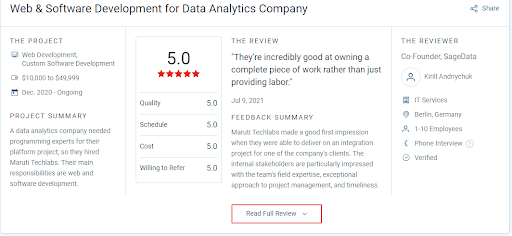
Our priority is to provide quick accessibility and response time to our clients. Being a reliable software product development service partner, we are delighted to recommend the finest technological solutions for your company, assist you in selecting the appropriate strategy for development, and provide you with a thorough estimate for your project.







